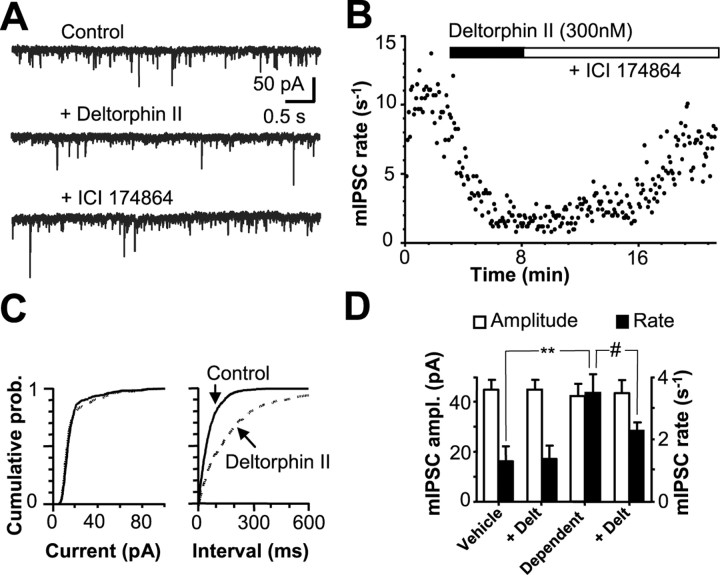Figure 1.
DELT inhibits GABAergic release in PAG neurons from chronically morphine-treated mice. A, Representative current traces (Vh =-60 mV) from a PAG neuron from a morphine-dependent mouse showing typical mIPSCs during withdrawal induced by CTAP in control ACSF (containing 5 μm CNQX, 300 nm TTX, 3 μm strychnine, 1 μm DPCPX, and 1 μm CTAP). Superfusion of the DOPr agonist DELT (300 nm) inhibits the mIPSC rate, and the inhibition is reversed by the DOPr antagonist ICI 174864. B, Time course of mIPSC rate for the neuron shown in A during superfusion of DELT and ICI 174864. C, Cumulative distribution plots of mIPSC interevent interval and amplitude before (continuous line) and during (dashed line) DELT application for the neuron shown in A and B. Cumulative plots show that DELT induces a rightward shift in the distribution of interevent intervals (p < 0.001; K-S test), indicating a decrease in mIPSC frequency, whereas it does not induce a significant variation in mIPSC amplitude (p > 0.1; K-S test). D, Histogram illustrating the effects of DELT on mIPSC parameters in PAG neurons from vehicle- and morphine-treated mice [cells that responded to DELT after withdrawal induced by either CTAP (n = 5) or washout of morphine for 1 h (n = 11)]. The rate of mIPSCs was significantly higher in dependent neurons compared with vehicle (p < 0.01). DELT (300 nm) significantly inhibited the mIPSC rate in neurons from dependent animals (p < 0.01) without affecting amplitude (ampl.) (p = 0.26). DELT did not affect the mIPSC rate or amplitude in neurons from vehicle-treated animals. **p < 0.01 versus vehicle; #p < 0.01 versus control.

